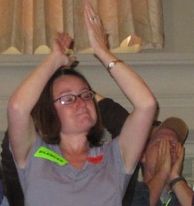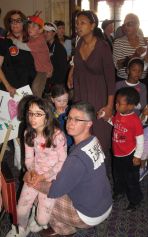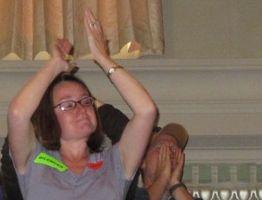
Last week’s victory for the arts — an Oakland city budget that closes a potentially crippling $58 million deficit without reducing funds for arts programs or libraries — came as a major surprise. Faced with one possible budget scenario from Mayor Jean Quan that axed all arts funds and closed most libraries, organizations and citizens had been hoping for the more equitable, across-the-board 15 percent reduction in city support that had also been proposed by the Mayor and adopted by four Oakland City Council members. Instead, City Council, the final arbiter of the budget, left support for arts and libraries unscathed, thereby affirming the major impact of the arts, artists, and libraries on the city’s health and vibrancy.
The Council’s decision was influenced by far more than finances. As much as the sizable commerce generated by concerts, performances, and artists of all stripes and persuasions contributes to Oakland’s coffers, Council members were equally aware of the huge community outreach efforts of the arts organizations that citizens’ tax dollars support. It was this larger embrace, on the part of both artists and cultural institutions, that contributed to the Council’s life-affirming decision. Balancing reactive and proactive efforts, the Council basically bucked the major trend we see on the federal level and embraced all aspects of community health and safety.
More than one Council member noted that the unusually high salaries of Oakland's public safety forces eat up two-thirds of the General Fund. Rather than capitulate to that inequity, the Council basically bucked the national trend to put "defense" over everything else, and instead embraced all aspects of community health and safety.
“Arts offer a way to strengthen the community in the midst of oppression, a way of remembering and conveying history and cultural stories that are central to human society.” — Council Member Rebecca KaplanSFCV spoke by phone with five of Oakland’s eight City Council members. Of the “Gang of Four” who initially proposed a 15 percent across-the-board reduction in arts funding, Libby Schaaf, Nancy Nadel, and Rebecca Kaplan discussed their personal history with the arts and their position. Of the “Gang of Three” whose initial proposal cut $720,000 of the $920,000 that Oakland annually gives the arts, Desley Brooks agreed to an interview. Ignacio de la Fuente, who submitted his own budget proposal, also spoke to the issues. The other Council members did not respond to queries.
Libby Schaaf and Rebecca Kaplan
Libby Schaaf (District 4) revealed that her uncle was a music critic for the San Francisco Chronicle. Her mother was president of the Oakland Symphony Guild and her godparents were former Oakland Symphony Manager Harold Lawrence and his wife, Mary. Following the example of her great great aunt, Fannie Bloomfield Zeisler, one of America’s first famed female concert pianists, Schaaf began studying classical piano at age 5.
Related Articles
Oakland Budget Preserves Arts Funding
July 1, 2011
Red Alert: Oakland Faces an Arts Funding Emergency
June 10, 2011
Schaaf is one of several Council members who acknowledged that the arts are “part of the soul of the city.” Such a spiritual affirmation is far from universal in our fair land: In Kansas, the governor recently defunded the Kansas Arts Commission.
“The arts are also part of our brand as we market ourselves as one of the creative hubs of the world,” said Schaaf. “Our arts community and our creative class generate tremendous economic wealth in businesses and other purchases that benefit us economically as both a city and a community.”

When Council Member-at-Large Kaplan chucked all self-promoting signage, and instead rode her bicycle among Oakland’s contingent in the San Francisco Pride Parade on June 26, she displayed the same iconoclastic spirit that sees her sporting a modest goatee and touting her Jewish heritage.
“Music has been part of the cultural formation of every culture on earth,” said Kaplan. “It’s been used to bring people together, to convey important meaning and history and stories, and to build community. In the Bible, we blow the ram’s horn to bring people together, and Miriam the prophetess leads people in dance and song. Arts offer a way to strengthen the community in the midst of oppression, a way of remembering and conveying history and cultural stories that are central to human society.”
Kaplan singled out the Oakland East Bay Symphony’s “substantial role” in building community, as well as its pioneering African-American leadership. She also praised the contributions of the Oakland Interfaith Gospel Choir and the Oakland School for the Arts.
At the same time, she affirmed the arts’ economic contribution. “We don’t just support the arts because it’s a nice thing to do,” she said. “They promote community harmony and are good for education. Businesses related to our arts center are growing, and have huge potential to continue to grow and generate new jobs and revenue.”
Nancy Nadel and Desley Brooks
Nancy Nadel (District 3), a longtime Council member, earned a bachelor of fine arts degree. A former high school and adult ed art teacher on both coasts, she is now a craftsperson and artisan chocolate maker.
Acutely aware of the importance of the arts, Nadel noted that her daughter left the Oakland public school system because, at the time she was ready to start high school, no public high school offered a music program for freshmen. “We lost a lot of enrollment because we didn’t have art programs in the school,” she said. “But the only thing the city government can do on that score is provide some money for after-school programs. Supporting the symphony in the schools is very important, however, and I hope we can continue to do that.”
Nadel’s late husband, a violinist, was probably the only African American in his high school orchestra. Right after he became first violinist, they closed down the orchestra. This made her acutely aware that even the African-American-led Oakland East Bay Symphony has very few people of color. This, she believes, has a very off-putting effect on many African-Americans.
“I am mindful of what it takes to run a whole city. I try to look holistically at an issue, not at issues in isolation.” — Council Member Desley Brooks“When I am most stressed, classical music is one of the few things that can calm me down,” she said. “I would love to be able to offer that same calming, soothing option to the rest of the city. But it is a matter of taste, as well, and not everybody vibrates to that music. It would be wonderful if we could have more and it would be more successful.”
Desley Brooks’ introduction to city politics was as vice chair of the Cultural Affairs Commission and chair of the public art committee. A longtime supporter of the arts, Brooks (District 6) stated that no one wanted to cut Oakland’s libraries, recreation centers, or anything else.
Though she affirmed that everyone was trying to be “reasonable” and look at solutions that would involve “the least amount of pain for people,” Brooks joined with the three members whose proposal stressed “core services” while axing all funds for the arts. Although her group later modified their position, indicating that they would support the alternative 15 percent reduction in arts funding, she stated, “Sometimes some things must be held off so you can just get through," she said. "Then we can build back up the things that we had."
“I don’t take this lightly,” she said. “These are very difficult decisions to make. I’m not going to say that I’m going to save the arts, to the exclusion of everything else. I am mindful of what it takes to run a whole city. I try to look holistically at an issue, not at issues in isolation.”
Ignacio de la Fuente on the Arts and Public Safety
Right off the bat, former labor organizer Ignacio de la Fuente (District 5) declared, “The crisis we were facing with senior citizens, art, and libraries would have been too much to take at one time.” Even though he did not come from a family that attended the symphony or ballet, he explained that his mother, who was a teacher, helped him understand the tremendous impact the arts have on the block, the school, and the community.
“Funding for the arts gives a 100-to-1 return on your investment, in terms of the pride and incredible incentive children get.” — Council Member Ignacio de la FuenteDe la Fuente contrasted the small amount that Oakland currently gives the arts with the huge police and fire salaries that eat up two-thirds of Oakland’s general fund. “I was one of two people who voted ‘no’ for the settlement with the police,” he declared unapologetically. “When people see the entire deal, I think they’re going to be very angry. [The police concessions] are smoke and mirrors. They are not giving much at all, while all the people in other unions are contributing a lot in this crisis.
“I was the first person to put 100 percent of arts funds back into the budget. For me, it was a realization that the police were going to get away with not really contributing their fair share. It was absolutely unfair. Everyone has got to pitch in, and every organization has to take a hit. We are raising our fees at swimming pools and tennis courts and recreation centers, yet we’re giving the police a 4 percent raise by January 2015, not only to active police but also to retirees. Plus, they now get to cash out their sick leave 2-to-1 for vacation days. They've made us agree that we cannot reopen the negotiations, put anything on the ballot, or declare a fiscal emergency! They don’t contribute a damn thing."
De la Fuente continued:
If the police were to give us a serious, serious concession, I could have agreed to a 15 percent reduction for the arts. But in my heart, I figure: Wait a minute, the most expensive department of the city, 45 percent of the budget, is also the most expensive police department in the country, period. It is unacceptable to me to reduce the arts one single penny while you’re giving other people a raise. So I said, ‘No way’ to the cuts.I’ve learned what it takes to make a city with a soul, a city that looks at a hundred different ways to deal with the challenges of urban environments. Funding for the arts gives a 100-to-1 return on your investment, in terms of the pride and incredible incentive children get.
I’ve grown to understand how dedicated our artists are. I’m very close to several artists who work 24/7 to teach dance. A very dear friend of mine is a dance teacher at the Malonga Casquelourd Arts Center. She works days and weekends to teach children from 3 to 11, and from 12 to teens, to sing, dance, and do art. I recognize the value, and that it makes a city vibrate; it makes a city a city.
The Final Word From Maestro Morgan
When longtime Oakland East Bay Symphony Music Director Michael Morgan addressed the City Council on June 21, he hoped, at best, for a 15 percent cut in support. Shocked and surprised that the arts and libraries emerged unscathed — at least for now — he remarked how well the decision speaks to the Council’s priorities.
“I don’t really know any arts organizations in town that aren’t doing a great deal of community engagement,” he declared. “Part of the reason that the Council could legitimately support the arts, even during this time, is because all the organizations are doing so much work in the community. As we’ve been saying for a long time, basically, ‘As the arts go, so goes Oakland.’ It’s very important that Oakland support this positive asset that lives to give back to its community.”

